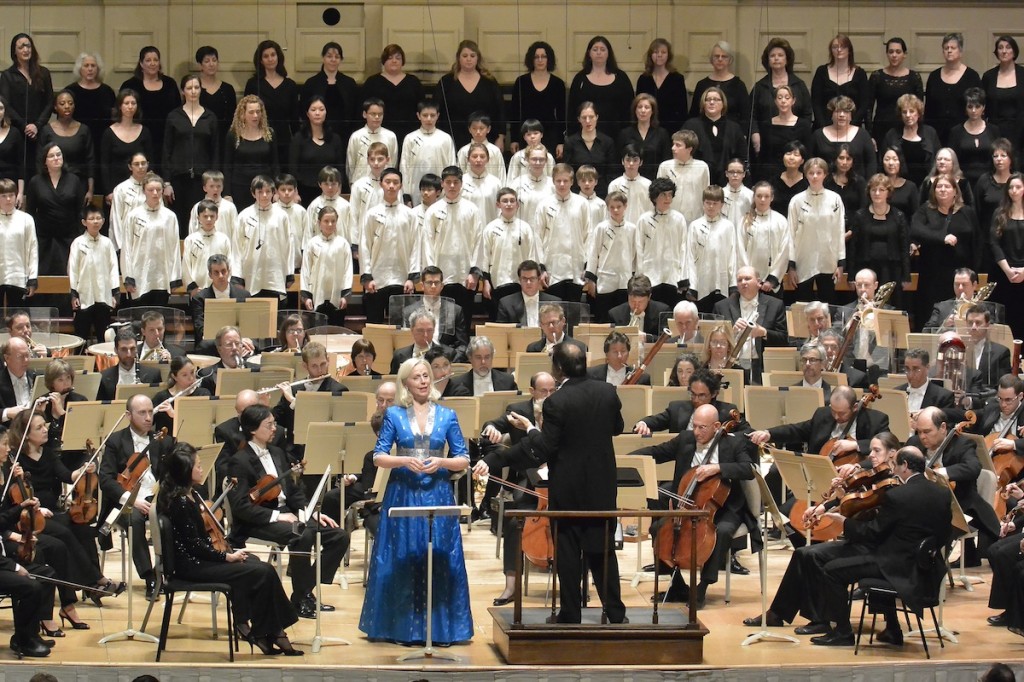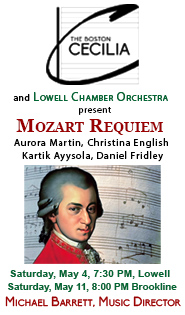Gatti, BSO put a modern edge on Mahler’s Third

Daniele Gatti conducting the BSO with mezzo-sopano Anne-Sofie von Otter and the Tanglewood Festval Chorus in Mahler’s Symphony No. 3. Photo: Stu Rosner.
If there is any doubt that Gustav Mahler was a twentieth-century composer, Daniele Gatti quickly dispelled it Thursday night as he led the Boston Symphony Orchestra in a taut, edgy performance of this composer’s Third Symphony.
In the work’s opening minutes, aggressive brass and grating string tremolos banished all thoughts of a well-upholstered Romantic sound for Mahler’s paean to Nature. Mahler once characterized the work’s long first movement as “The Sun marches in,” and this sun was a particularly intense one, casting the darkest of shadows, then lighting every corner of Mahler’s score in a merciless glare.
Composed in 1895-96 but not published or performed in full until 1902, this work does have a foot in both centuries, and Gatti made abundantly clear which perspective he brought to it. Unwavering focus on his conception of the work, coupled with the commitment and skill of the BSO players, made a compelling case for an interpretation that, in other hands, might have seemed crude or extreme.
Gatti made the most, for example, of Mahler’s modernistic tendency to single out players as individuals rather than as elements in the orchestral blend. In Thursday’s performance, especially in the early going, a trumpet or a trombone could be as arresting as an operatic hero or villain striding the stage, singing “in character,” be it bold, sarcastic, cajoling, or menacing.
But as the movement’s march rhythms came to the fore, they brought a sense of orchestral texture with them, ranging from lacy to morose to shrill, but always transparent. The economical Gatti often stopped beating time in these sections, leaving the rhythm up to the collective sense of the players, and limiting himself to signaling a nuance here and there. But there was no question that his ear was in control of the finely balanced sound.
The conductor’s strong sense of dramatic pacing produced exciting climaxes and eager anticipation of what came next. He sustained the suspense through the long movement’s most static passages.
The symphony’s middle movements, sometimes referred to as character pieces or even comic relief, sounded on Thursday all of a piece with the work’s dramatic design. The second movement, though quaintly marked Tempo di Menuetto, came off as an anxious minuet indeed, nervously looking over its shoulder even during its most saccharine moments. Despite the sparkling scoring and ballet gestures, this was no Tchaikovsky neo-rococo.
A fast but easy rhythm propelled much of the third movement, from the light-footed strings to the rude interruptions of the brass. This was a cheerful bit of Austrian “country music,” circa 1902; the sound of the posthorn, near and far, would have had the same nostalgic effect on the symphony’s first hearers as a distant railroad whistle does on Americans today. In the magical pauses for dialogue between a distant trumpet and high strings and horns, the balance of instruments shifted subtly and constantly, a marvelous atmospheric effect.
Then night fell quietly on this symphony, if not quite as quietly as Mahler indicated (“durchaus ppp,” triple-pianissimo throughout). While horns and strings could not quite shed the “present” sound that characterized so much of this performance, they played sensitively and with restraint.
Mezzo-soprano Anne Sofie von Otter intoned the short phrases of Nietzsche’s “Midnight Song” with delicacy and dignity at a piano dynamic, her restrained vibrato and soft attacks creating the illusion of pianissimo.
Although the fifth movement is a buoyant setting of a folk poem about Jesus, a sinner, and heaven featuring high voices and jangly percussion, Gatti kept it within the expressive arc of the whole performance, not allowing the children’s choir to get too raucous with their bell-ringing sounds or the women singers too pert with their narration. Von Otter also played it straight as the sinner, and the two vocal groups—women of the Tanglewood Festival Choir and PALS Children’s Chorus—executed their parts with bounce and precision.
Two of Mahler’s markings for the last movement, “Slow” and “Deeply felt,” accurately characterized Thursday’s performance. The third, “Full of peace” (Ruhevoll), had to yield to the tension that Gatti was maintaining throughout the work. The conductor kept the tempo steady yet expressive to start, and then expertly managed all of the long movement’s complications, especially the climactic confrontation with darker themes from earlier in the work.
During a quiet passage near the end, the music was interrupted when a woman chorister fainted and fell among the chorus seats. She was assisted to a backstage area, and Gatti also left the stage for a minute or two, presumably to check on her condition, before returning to finish the performance.
After an understandably shaky start, the orchestra pulled together and brought the symphony to its glowing conclusion. Having (with some effort) observed concert etiquette and withheld applause for the entire evening, the audience now gave conductor, orchestra, soloist, and choruses a prolonged ovation.
The program will be repeated 8 p.m. Friday and Saturday. bso.org; 617-266-1200.
Posted in Performances

Posted Mar 29, 2013 at 2:29 pm by Michael Chen
I find myself in almost complete agreement with your review here except that the finale, at glacial pace, was “too” slow for me to sustain the natural unfolding of Mahler’s Love Song of Life. Gatti was impressive in bringing out the texture, most detailed phrasing nuances, Harmonic contrast in the first three movements, though such detailed rendition did occasionally come across as a bit suffocating or mechanical. That’s to be expected especially in the first complete performance. Hopefully the subsequent concerts will restore more spontaneity and natural fluency to the music. Nonetheless I was very impressed by this wholly deconstructed-reconstructed approach.
Posted Mar 29, 2013 at 11:12 pm by julia soret
Viva Gatti!